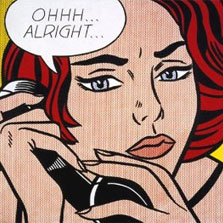| Pop Art History > Dictionary | ||||
|
Pop Art DictionaryHere's are some terms and questions that you may encounter as you discover more about pop art.Pop artAn artistic movement notable for its tendency to throw away the usual notions of fine art and to focus on or parody mass media and popular culture. Pop art can be in any sort of visual medium, including painting, sculpture, drawing, film, or art installation. Pop artistAn artist whose work is inspired by, or is a parody or commentary on, popular culture, and whose work tends to fall into the style and technique of the pop art movement. Examples include Andy Warhol, Roy Lichtenstein, and Richard Hamilton, among others. Campbell's Soup CanMany works by Andy Warhol consisted of a still life, simple image of a can of Campbell's soup. His most famous of these works is the Campbell's Soup I, which consisted of a can of tomato soup, specifically. Pop art artworkArt in any medium, sculpture, painting, installation, etc, which falls within the realm of the pop art movement. Usually this kind of artwork focuses on the very common experience and popular imagery of the everyday person, rather than having a focus on creating fine art in the classic style. Often, this kind of art remixes or satirizes popular culture or everyday objects that most people in the culture may encounter. For example, Andy Warhol's Campbell's Soup Cans were depictions of very mundane objects that most people viewing his work would have already been familiar with. Popular cultureThe general common ideas, customs, values, and experience of a given group of people, usually the wider majority culture. This is contrasted with sub-cultures which are small subsets of the wider, popular culture, and may be very different in its values and shared ideas. The term “popular culture” especially refers to the common imagery and symbolism that everyday people understand, such as those from popular movies, books, television shows, advertising, and news media. This stands in contrast to more elitist ideas of culture, such as those understood by an intellectual minority. CollagesA kind of artistic technique in the visual arts which involves putting together many different unrelated pieces to form a larger whole. Often, the collage will be made from pieces of other already-existing works—for example, from photographs in magazines, or from images and shapes created by other artists—to create a new work that is made from all of these pre-existing elements. SilkscreenAlso known as screen printing, this is an artistic technique that involves pushing ink through a sieve-like mesh (a screen) and onto the final medium, such as cloth. This works as a sort of stenciling technique, since part of the mesh will be blocked off and the ink can only leak through the open holes, thus leaving a particular image on the medium. It was a technique that was popularized by Andy Warhol for use in the arts. Over time, it became a common technique used to print imagery on T-shirts, and is still used to this day.

|
|||||||||
| Pop Art History | What is Pop Art? | Origins of Pop Art | American Pop Art | British Pop Art | Independent Group | Artworks Top 10 Famous Artworks | Roy Lichtenstein | Richard Hamilton | Andy Warhol | Timeline | | FAQ | Citations | References | Websites Pop Art History - All artworks copyright belong to the artist - Reproduction is strictly prohibited |

